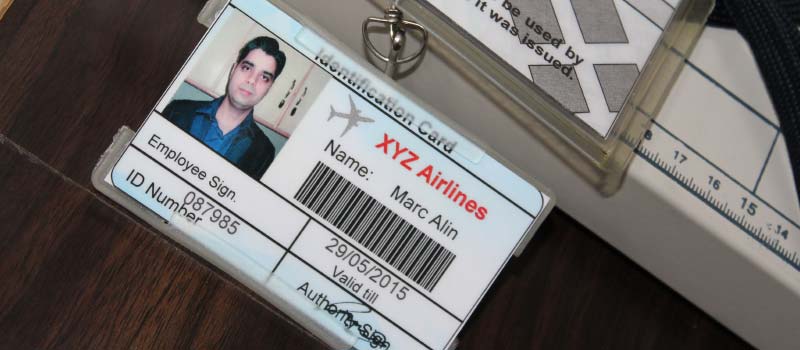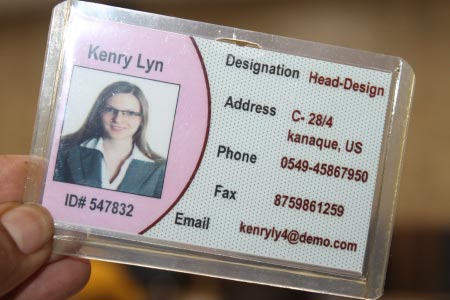📅 01/08/2023
Here are the details on how you can add a photo to your ID badge design:

-
Capture a Suitable Photo:
To add a photo to your ID badge, you need to start by capturing a suitable photograph of the individual. The photo should be clear, well-lit, and capture the person's face without any obstructions. It is recommended to follow certain guidelines, such as a neutral background, proper lighting, and the individual facing the camera directly. This ensures that the photo accurately represents the person and is easily recognizable.
-
Prepare the Photo:
Once you have captured the photo, it may require some preparation before incorporating it into the ID badge design. This includes cropping the photo to the desired size and adjusting the brightness, contrast, or color if needed. The goal is to ensure that the photo is clear and the person's face is easily visible.
-
Designing the ID Badge Layout:
Now, you can proceed to design the ID badge layout, which includes adding the photo to the design. You can use graphic design software or dedicated ID badge design tools to create the layout. Start by creating a blank canvas or template in the desired size (e.g., CR80 format) with appropriate dimensions.
-
Size and Dimensions:
Resize the prepared photo to fit the designated area on the ID badge layout. Ensure that the photo is neither too small, making it difficult to identify the person, nor too large, overwhelming the other elements on the badge. Aim for a proportional size that maintains clarity and allows for easy recognition.
-
Image Editing and Background Removal:
Depending on the design preferences and requirements, you may need to edit the photo further. This can include removing the background to create a clean and professional look. Background removal can be achieved using image editing software, or you can utilize specialized tools that automate this process.
-
Inserting the Photo:
Once the photo is ready, you can insert it into the ID badge layout. Use image editing tools to place the photo in the designated area and ensure it fits well within the allocated space. Align the photo properly to maintain visual aesthetics and avoid any overlapping with other elements.
-
Placement of the Photo:
Decide on the placement of the photo within the ID badge design. The most common and recommended location is the upper portion of the badge, usually the left or right corner. This placement ensures that the photo is clearly visible and does not interfere with the other essential information on the badge, such as the person's name, title, or organization logo.
-
Finalize the Design:
After adding the photo, proceed to finalize the ID badge design by incorporating other relevant information such as the person's name, title, employee number, or department. Include any additional security features, such as a barcode, hologram, or signature area, if required. Ensure that the overall design is visually appealing, legible, and complies with organizational branding guidelines.
-
Printing the ID Badges:
Once the ID badge design is complete, you can proceed to print the badges using an ID card printer. Ensure that the printer settings, such as print quality, color calibration, and alignment, are appropriately configured to achieve the desired results. Use high-quality printing materials, such as PVC cards, for durability and longevity.
➔By following these detailed steps, you can successfully add a photo to your ID badge design.
Information Should be Included on an ID Badge
An ID badge, also known as an identification card or a security badge, typically serves as a visual means of identification for individuals within an organization, institution, or company. The information included on an ID badge can vary depending on the specific needs and policies of the organization, but there are some common elements that are typically present. Here's a detailed explanation of the information that should be included on an ID badge:

-
Full Name:
The badge should prominently display the full name of the individual. This helps in quickly identifying the person and verifying their identity.
-
Photograph:
A recent photograph of the badge holder is essential for visual identification. The photo should be clear, well-lit, and of sufficient size to easily recognize the person. It is typically placed near the top of the badge.
-
Job Title or Position:
Including the job title or position of the individual helps others quickly determine their role within the organization. It provides a visual cue about the person's responsibilities and authority level.
-
Company or Organization Logo:
The logo represents the company or organization the individual belongs to. It helps to establish the badge's legitimacy and affiliation with a specific entity. The logo is often placed at the top or bottom of the badge.
-
Employee ID Number:
An employee ID number is a unique identifier assigned to each employee within an organization. It aids in tracking and managing employee records, access control, and timekeeping. It may be displayed as a barcode, a QR code, or simply as a numeric value.
-
Department or Division:
Including the department or division name helps identify the specific area of responsibility or specialization of the individual. This is particularly useful in larger organizations where employees may work in different departments or locations.
-
Validity or Expiry Date:
To ensure the badge remains current and up to date, it is important to include a validity or expiry date. This date indicates when the badge becomes invalid or needs to be renewed. This information helps with access control and security protocols.
-
Access Levels or Permissions:
If the ID badge is used for access control purposes, it may include information about the access levels or permissions granted to the individual. This can be indicated through color-coded badges, symbols, or text that specify the areas or resources the person is authorized to access.
-
Contact Information:
Including contact information, such as a phone number or email address, allows others to easily get in touch with the badge holder if needed. This is particularly useful for security personnel or supervisors who may need to reach the individual quickly.
-
Additional Security Features:
Depending on the level of security required, ID badges may incorporate additional security features such as holograms, watermarks, embedded chips, or magnetic strips. These features enhance the badge's authenticity and make it more difficult to counterfeit.
-
Emergency Information:
In some cases, ID badges may include emergency information such as emergency contact numbers or medical conditions of the individual. This information helps in situations where immediate assistance or medical attention is required.
NOTE:- It's important to note that the specific information included on an ID badge may vary depending on the organization's policies, industry regulations, and the level of security required. These guidelines provide a general overview of the common elements found on ID badges, but organizations have the flexibility to customize them to suit their specific needs.